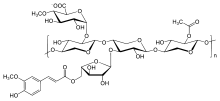Xylan

Xylan (CAS number: 9014-63-5) is a group of hemicelluloses that are found in plant cell walls and some algae. Xylans are polysaccharides made from units of xylose (a pentose sugar). Xylans are almost as ubiquitous as cellulose in plant cell walls and contain predominantly β-D-xylose units linked as in cellulose.
Typically the content of xylans in hardwoods are 10 - 35 % of the hemicelluloses and in softwoods they are 10 - 15 % of the hemicelluloses. The main xylan component in hardwoods is O-acetyl-4-O-methylglucuronoxylan and in softwoods the main xylan components are arabino-4-O-methylglucuronoxylans. In general softwood xylans differ from hardwood xylans by the lack of acetyl groups and the presence of arabinose units linked by α-(1,3)-glycosidic bonds to the xylan backbone.[1]
Some green algae contain xylan, especially macrophytic siphonous genera, where it replaces cellulose. Similarly, it replaces the inner fibrillar cell-wall layer of cellulose in some red algae.
Xylan is one of the foremost anti-nutritional factors in common use feedstuff raw materials.
Xylooligosaccharides produced from xylan are considered as "functional food" or dietary fibers.[2] New enzymes from yeast are discovered which exclusively converts xylan into only xylooligosaccharides-DP-3 to 7.[3]
References
- ↑ Sixta, Herbert, ed. (2006). Handbook of pulp 1. Weinheim, Germany: Wiley-VCH Verlag GmbH & Co. KGaA. pp. 28–30. ISBN 978-3-527-30999-3.
- ↑ Alonso JL, Dominguez H, Garrote G, Parajo JC, Vazques MJ (2003). "Xylooligosaccharides: properties and production technologies". Electron. J. Environ. Agric. Food Chem 2 (1): 230–232.
- ↑ Adsul, MG; Bastawde, KG; Gokhale, GV (2009). "Biochemical characterization of two xylanases from yeast Pseudozyma hubeiensis producing only xylooligosaccharides". Bioresource Technology 100 (24): 6488–6495. doi:10.1016/j.biortech.2009.07.064.